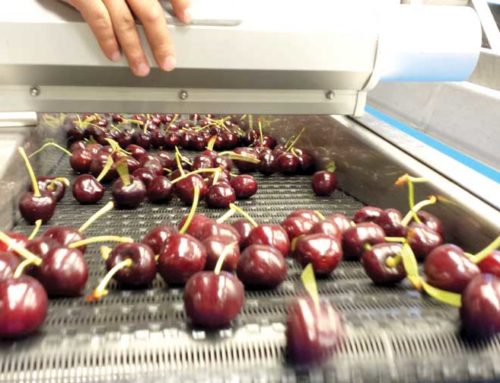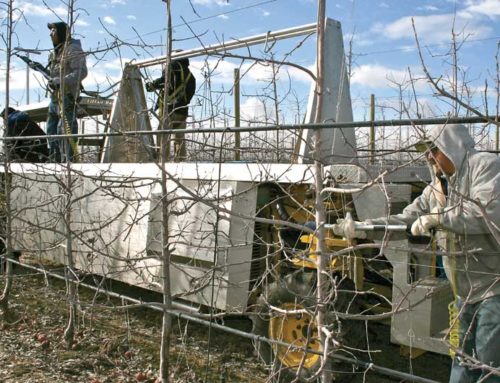
Dr. Jay Brunner
Washington State University
Guthion (azinphos-methyl) is still an effective and cheap way to control codling moth in most cases, but Dr. Jay Brunner, a Washington State University entomologist based in Wenatchee, Washington, is urging growers to try to manage without it. The newer alternatives don’t give quite the same level of control, they cost more, and require better coverage on the tree, but Brunner said there are other considerations: Newer products are considered safer for workers.
Reentry intervals are much shorter (usually 4 to 12 hours compared with 14 days for Guthion), and employees using them don’t need cholinesterase tests that are required by Washington State for workers handling organophosphates or carbamates. They’re also less harsh on the environment and wildlife, and buffer zones are not required when the newer products are used next to streams and rivers. Most of the products allow the survival of biocontrol agents in the orchard.
In addition, codling moth has been developing resistance to Guthion in some areas. “I think it’s time to start preparing for an environment where we don’t have organophosphates available or they’re more restricted than they currently are,” Brunner told growers at the Washington State Horticultural Association’s convention. “We know we have a list of materials that can be effective if used properly.” Rimon (novaluron) is a new pesticide that should be available this season in Washington under a special local needs exemption. It has provided good control in trials.
Know new technology
Brunner said it’s important to know how to use some of the new technologies, and part of it is faith. For example, Esteem (pyriproxifen) is an insect growth regulator that prevents the larvae from molting successfully into the pupal stage. However, the caterpillars don’t die. They can molt a couple of extra times and get quite big.
Whereas traditional pesticides kill larvae on contact as they crawl across the residues, most of the newer insecticides, such as Assail (acetamiprid), Calypso (thiacloprid), Intrepid (methoxyfenozide), Rimon (novaluron), and the codling moth virus, act by ingestion, Brunner said.
Some of the products are ovicides. Oil, Assail, and Calypso are applied after the eggs are laid, but Esteem is applied so it covers the plant surface before the eggs are laid to prevent the development of the eggs. Intrepid and Rimon work either way and offer some flexibility in how they might be applied.
Traditional program
A traditional control program for codling moth and leafrollers begins with Lorsban (chlorpyrifos) and oil in the dormant season, and three Guthion applications and possibly one application of the organophosphate Imidan (phosmet) during the growing season.
Softer program
In a softer program, Lorsban might be used at the delayed dormant stage, but Assail or Calypso might be used in place of the second Guthion spray and Intrepid in place of the third. Although the newer products are not quite as effective as Guthion, under normal pressure the grower would not see a difference, Brunner said. Intrepid is not as effective in a high-pressure situation, but an added benefit is that if there are leafrollers in the orchard, it will suppress those at the same time.
OP alternatives
A program without any organophosphates might start with oil at the delayed dormant stage in place of Lorsban and an ovicide such as Rimon or Esteem at petal fall, which will also control leafrollers. Then, a larvicide, such as Assail or Calypso, can be used to target the first generation, and Intrepid for the second generation. All these programs work best in combination with mating disruption, which can help reduce pesticide use, Brunner said.
The different classes of chemistry should be alternated to avoid development of resistance, he cautioned. Don’t use the same chemistry against codling moth when leafrollers are present and then again against leafrollers. Don’t use Assail for the first generation of codling moth and Calypso for the second because they are both in the neonicotinoid class of pesticides. “The best resistance management strategy is not to use insecticide unless you have to,” Brunner said, urging growers to monitor orchards and only apply insecticides when justified.
Tank mixes
New products with different modes of action can also be used in tank mixes. For example, oil could be applied at 200 degree days to kill the eggs laid since the beginning of the codling moth flight. Brunner said oil can be very effective if the coverage is good. Then, a tank mix of an ovicide (Rimon or Intrepid) and a larvicide (Assail or Calypso) could be applied as a delayed first cover spray at 350 degree days.
The ovicide would kill the eggs that the oil missed or were laid after the oil treatment, and larvicide would kill the small larvae as they attempted to enter the fruit. When the tank mix application is delayed to 350 degree days, the products should have enough residual activity to cover the entire first generation, Brunner said. This could be followed by a combination of a different larvicide and ovicide or the codling moth granulosis virus in the second generation.
Entrust (the organic formulation of Success) has been useful in organic orchards for bringing codling moth under control where damaged fruit has reached unacceptable levels of perhaps 10 to 15 percent, Brunner reported. “We’ve been able to rescue many of these orchards with Entrust in combination with pheromones.”






Leave A Comment